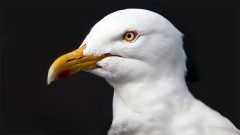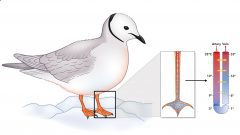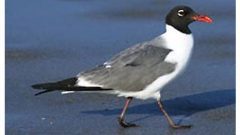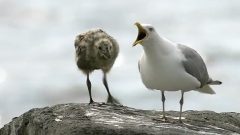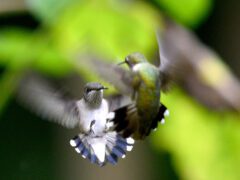American Herring Gull Similar Species Comparison
Main SpeciesAmerican Herring Gull
Breeding adult
Large gull with a somewhat large, but slim bill and robust body. Breeding adults have clean white heads and underparts with pale gray backs and wings. Note pale legs and yellow eye.
© Simon Boivin / Macaulay LibraryQuebec, July 19, 2019Nonbreeding adult
Nonbreeding adults have extensive tan streaking on their neck. Note the pale gray upperparts and the pale eye.
© G & B / Macaulay LibraryConnecticut, October 22, 2016Breeding adult
A large, barrel-chested gull with pink legs in all plumages. Breeding adult has light gray upperparts, clean white underparts, a white head, yellow eyes, a fairly slim bill with a red mark, and mostly black wingtips with some white markings.
© Greg Baker / Macaulay LibraryQuebec, August 31, 2016Third winter
Third winter birds start to acquire pale gray feathers on their back, but still have extensive tan streaking on their head and neck. Note pale yellow eye.
© Evan Lipton / Macaulay LibraryRhode Island, December 26, 2016Third winter
This more advanced third winter bird looks nearly like an adult, with its pale gray back, but it still has streaking on the neck and a black band around its bill.
© Evan Lipton / Macaulay LibraryRhode Island, December 26, 2016Breeding adult
Characteristic "long call" and display involves leaning forward, lowering the head, and giving an extended series of loud cries.
© DAVID BROWN / Macaulay LibraryMaine, July 10, 2007Second winter
The second winter gull is heavily streaked throughout with a few gray back feathers coming in. Note dark primaries, lacking white tips.
© Chris Wood / Macaulay LibraryNew York, November 08, 2015Second winter
Some second winter birds have less streaking on their necks and look very pale overall, but note its pale eye and pink legs.
© Alex Lamoreaux / Macaulay LibraryFlorida, February 16, 2017Breeding adults
Pairs often feed each other as part of courtship. Females are usually smaller than males; this one is soliciting food from her partner using begging motions similar to those used by chicks.
© DAVID BROWN / Macaulay LibraryMaine, April 28, 2007Juvenile
Juveniles are tan overall with tan-and-white checker boarding on their back. Juveniles have an entirely dark bill and a dark eye.
© Evan Lipton / Macaulay LibraryMassachusetts, August 06, 2014Breeding adult
In flight, they look barrel-chested and broad-winged. Pale gray above with dark wingtips with only small white spots (aka "mirrors") on the dark tips.
© Jeremiah Trimble / Macaulay LibraryMaine, May 29, 2017Breeding adult and juvenile
Juveniles are brown with black bills. This one begs and receives regurgitated food from a parent, as the other parent moves in and also eats the food. Afterward, the two adults perform "long calls."
© DAVID BROWN / Macaulay LibraryMaine, August 08, 2007Juvenile
Juveniles in flight have dark primaries without the white spots or mirrors and a thick dark band across their tail.
© Louis Bevier / Macaulay LibraryMaine, August 02, 2017Habitat
Found along both coasts and near large reservoirs, lakes, and major rivers. They feed in habitats as diverse as open water, mudflats, plowed fields, and garbage dumps, and gather in almost any open space near food.
© Jay McGowan / Macaulay LibraryNew York, July 15, 2017Similar SpeciesRing-billed Gull
Breeding adult
Ring-billed Gulls are smaller and more daintily built than American Herring Gulls. Breeding birds have yellow legs and a black line around the bill, whereas breeding American Herring Gulls have pink legs and a red mark on the lower bill.
© Jeremy Collison / Macaulay LibraryNew York, July 28, 2017Similar SpeciesRing-billed Gull
Second winter
Size can help separate Ring-billed Gulls from American Herring Gulls at all ages. Ring-billed Gulls are smaller with a daintier body than American Herring Gulls.
© Tom Edell / Macaulay LibraryCalifornia, August 16, 2017Similar SpeciesRing-billed Gull
First winter
First winter Ring-billed Gulls in general have less streaking on the underparts than first or second winter American Herring Gulls.
© Brad Walker / Macaulay LibraryNew York, February 27, 2016Similar SpeciesCalifornia Gull
Breeding adult
Breeding adult California Gulls have a dark eye unlike breeding American Herring Gulls, which have a pale yellow eye. California Gulls also have yellow legs, not pink like American Herring Gulls.
© Brian Sullivan / Macaulay LibraryCalifornia, August 01, 2008Similar SpeciesCalifornia Gull
Nonbreeding adult
Nonbreeding adult California Gulls have dark eyes and yellow legs, whereas nonbreeding American Herring Gulls have pale eyes and pink legs.
© Ben Bright / Macaulay LibraryIdaho, January 28, 2017Similar SpeciesCalifornia Gull
First winter
First winter California Gulls can be separated from first winter American Herring Gulls by their smaller size and wings that stick our farther past the end of the tail.
© Steven Mlodinow / Macaulay LibraryBaja California Sur, March 19, 2009Similar SpeciesGlaucous-winged Gull
Breeding adult
Breeding and nonbreeding adult Glaucous-winged Gulls have pale gray wingtips unlike adult American Herring Gulls, which have black wingtips.
© Shawn Billerman / Macaulay LibraryOregon, June 28, 2017Similar SpeciesGlaucous-winged Gull
Second winter
First and second winter Glaucous-winged Gulls have pale tan wingtips, whereas first and second winter American Herring Gulls have dark brown wingtips.
© Brian Sullivan / Macaulay LibraryCalifornia, December 18, 2007Similar SpeciesIceland Gull
Adult (Iceland)
Adult "Iceland" Iceland Gulls have pale wingtips unlike the dark wingtips on adult American Herring Gulls. Their bill is also smaller and slimmer than American Herring Gulls.
© Jeremiah Trimble / Macaulay LibraryMassachusetts, March 03, 2012Similar SpeciesIceland Gull
Nonbreeding adult (Thayer's)
Nonbreeding "Thayer's" Iceland Gulls have paler gray wingtips than nonbreeding American Herring Gulls. They also have a darker eye and a slimmer bill.
© Brian Sullivan / Macaulay LibraryCalifornia, November 30, 2015Similar SpeciesIceland Gull
First winter (Thayer's)
First winter "Thayer's" Iceland Gulls look very similar to first winter American Herring Gulls, but they have a slimmer bill and appear more round-headed than American Herring Gulls.
© Brian Sullivan / Macaulay LibraryCalifornia, November 18, 2016Similar SpeciesWestern Gull
Breeding adult
Breeding adult Western Gulls are a darker shade of gray than American Herring Gulls. Their bill is also more bulbous than the bill on American Herring Gulls.
© Joel Rurik / Macaulay LibraryOregon, April 12, 2016Similar SpeciesWestern Gull
Nonbreeding adult
Nonbreeding adult Western Gulls have very little tan streaking on their neck unlike the heavily streaked nonbreeding adult American Herring Gull.
© Christoph Moning / Macaulay LibraryCalifornia, August 25, 2012Similar SpeciesWestern Gull
Second winter
Second winter Western Gulls have darker gray feathers coming in on their back than second winter American Herring Gulls. They also have a heavier and bulbous-shaped bill.
© Bernardo Alps / Macaulay LibraryCalifornia, February 10, 2017Similar SpeciesWestern Gull
First winter
Bill size and shape may be the best way to separate first winter Western Gulls from younger American Herring Gulls. The bill on Western is heavier with a bulbous shape, unlike the rather slim and straight bill on American Herring Gulls.
© Bernardo Alps / Macaulay LibraryCalifornia, January 24, 2017Similar SpeciesLesser Black-backed Gull
Nonbreeding adult
Lesser Black-backed Gulls are darker gray above than American Herring Gulls. They also have yellow (not pink) legs.
© Dorian Anderson / Macaulay LibraryFlorida, February 25, 2015Similar SpeciesLesser Black-backed Gull
Juvenile
Juvenile Lesser Black-backed Gulls can be separated from juvenile or first winter American Herring Gulls by their smudgy black eye patch.
© Jay McGowan / Macaulay LibraryNew York, March 25, 2011Similar SpeciesGreat Black-backed Gull
Breeding adult
Great Black-backed Gulls are larger than American Herring Gulls with much darker upperparts.
© Evan Lipton / Macaulay LibraryRhode Island, March 21, 2017Similar SpeciesGreat Black-backed Gull
Second winter
Second winter Great Black-backed Gulls have paler heads than second winter or first winter American Herring Gulls. They also have a heftier bulbous bill that is pink at the base and the tip.
© Gates Dupont / Macaulay LibraryMassachusetts, January 12, 2016Compare with Similar Species
Click on an image to compare
Species in This Family
Gulls, Terns, and Skimmers(Order: Charadriiformes, Family: Laridae)
More to Read
Don't miss a thing! Join our email list
The Cornell Lab will send you updates about birds,
birding, and opportunities to help bird conservation.


































